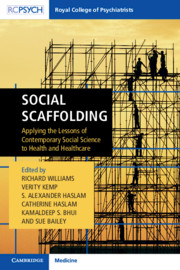Book contents
- Social Scaffolding
- Social Scaffolding
- Copyright page
- Contents
- Contributors
- Foreword
- Note
- Section 1 Schooling
- Section 2 Scoping
- Section 3 Sourcing
- Section 4 Scaffolding
- Chapter 23 Making Connectedness Count: From Theory to Practising a Social Identity Model of Health
- Chapter 24 Public Health Values and Evidence-Based Practice
- Chapter 25 Social Scaffolding: Supporting the Development of Positive Social Identities and Agency in Communities
- Chapter 26 Synthesising Social Science into Healthcare
- Chapter 27 Relationships, Groups, Teams and Long-Termism
- Chapter 28 Caring for the Carers
- Chapter 29 The Importance of Creating and Harnessing a Sense of ‘Us’: Social Identity as the Missing Link Between Leadership and Health
- Chapter 30 Smithtown as Society
- Section 5 Sustaining
- Index
- References
Chapter 26 - Synthesising Social Science into Healthcare
from Section 4 - Scaffolding
Published online by Cambridge University Press: 14 June 2019
- Social Scaffolding
- Social Scaffolding
- Copyright page
- Contents
- Contributors
- Foreword
- Note
- Section 1 Schooling
- Section 2 Scoping
- Section 3 Sourcing
- Section 4 Scaffolding
- Chapter 23 Making Connectedness Count: From Theory to Practising a Social Identity Model of Health
- Chapter 24 Public Health Values and Evidence-Based Practice
- Chapter 25 Social Scaffolding: Supporting the Development of Positive Social Identities and Agency in Communities
- Chapter 26 Synthesising Social Science into Healthcare
- Chapter 27 Relationships, Groups, Teams and Long-Termism
- Chapter 28 Caring for the Carers
- Chapter 29 The Importance of Creating and Harnessing a Sense of ‘Us’: Social Identity as the Missing Link Between Leadership and Health
- Chapter 30 Smithtown as Society
- Section 5 Sustaining
- Index
- References
Summary
This book presents a compelling weight of evidence about how belonging to social groups confers advantages that help people to achieve and sustain good physical and mental health. A huge volume of work has been done to take the evidence-base to where it currently stands. But, arguably, the work required to embed these psychosocial understandings and, importantly, their implications for healthcare, is a larger and more challenging task. The contents of Chapters 23, 24 and 25 should be real assets in so doing.
One of the intentions of this book is to identify effective methods that can be applied to improving healthcare outcomes and delivery. However, linking people’s social relationships with their health, their social groupings, their communities and, within them, health and social care service functioning is undeniably complex involving far more than changing or adding a service.
- Type
- Chapter
- Information
- Social ScaffoldingApplying the Lessons of Contemporary Social Science to Health and Healthcare, pp. 257 - 273Publisher: Cambridge University PressPrint publication year: 2019

